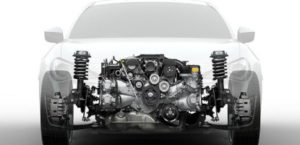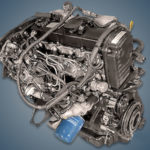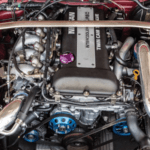The 2.0-liter Nissan QR20DE engine (or QR20 for short) was assembled at a Japanese plant from 2000 to 2012 and installed in a number of mid-size models of the concern, such as Primera, Serena or X-trail.
The engine was developed to replace its popular predecessor SR20DE. The new engine with distributed injection had a progressive design for that time: an in-line aluminum cylinder block with an open cooling jacket and cast-iron liners, an aluminum 16-valve cylinder head without hydraulic compensators, an intake phase control system, a timing chain drive, individual ignition coils, as well as a couple of balancing shafts.
The QR family also includes internal combustion engines: QR20DD, QR25DE, QR25DD and QR25DER.
The engine was installed on:
- Nissan Avenir 2 (W11) in 2002 – 2005;
- Nissan Caravan 5 (E25) in 2007 – 2012;
- Nissan Prairie 3 (M12) in 2001 – 2004;
- Nissan Primera 3 (P12) in 2001 – 2007;
- Nissan Serena 2 (C24) in 2002 – 2012;
- Nissan Teana 1 (J31) in 2003 – 2008;
- Nissan Wingroad 2 (Y11) in 2001 – 2005;
- Nissan X-Trail 1 (T30) in 2000 – 2007.
Specifications
| Manufacturer | Yokohama Plant |
| Production years | 2000-2012 |
| Cylinder block alloy | aluminum |
| Fuel system | distributed injection |
| Configuration | inline |
| Number of cylinders | 4 |
| Valves per cylinder | 4 |
| Piston stroke, mm | 80.3 |
| Cylinder bore, mm | 89 |
| Compression ratio | 9.9 |
| Displacement, cc | 1998 |
| Power output, hp | 147/6000 |
| Torque output, Nm / rpm | 200/4000 |
| Fuel type | petrol |
| Euro standards | Euro 3/4 |
| Weight, kg | 120 |
| Fuel consumption, L/100 km (for Nissan Primera 2005) — city — highway — combined |
11.7 6.7 8.5 |
| Oil consumption, gr/1000 km | up to 500 |
| Recommended engine oil | 0W-30 / 5W-20 / 5W-30 / 5W-40 / 10W-30 / 10W-40 / 10W-60 / 15W-40 / 20W-20 |
| Engine oil capacity, liter | 3.9 |
| Oil change interval, km | 15000 |
| Normal engine operating temperature, °C | ~90 |
| Engine lifespan, km | ~300 000 |
Disadvantages of the QR20DE engine
- Until 2004, power units were constantly flooded with candles during cold starts, the catalyst was destroyed from excess fuel, and its crumbs fell into the combustion chambers. A revocable company was held to flash the control unit and replace the catalyst.
- The most famous engine problem is the oil burner, which can appear as early as 150,000 km due to the occurrence or critical wear of the oil scraper rings. The reason may be the ellipse of the cylinders, the aluminum block does not hold the geometry.
- A thin leaf Morse chain usually stretches to runs of 150 – 200 thousand km, which is expressed in extraneous noise from the engine or floating idle speeds. Often, along with the circuit, you also have to change the phase regulator, which greatly increases the price.
- Thermostats are not very reliable and the cylinder head gasket constantly breaks through. Since the control unit signals overheating only when the engine is already really boiling, it is easy to wait for the deformation of the head and even the appearance of microcracks.
- Also, revolutions often float here due to contamination of the throttle or a breakdown of its gasket, oil leaks regularly occur from under the valve cover, and the crankshaft position sensor serves quite a bit. And do not forget about the periodic adjustment of the valve clearance, there are no hydraulic lifters.






